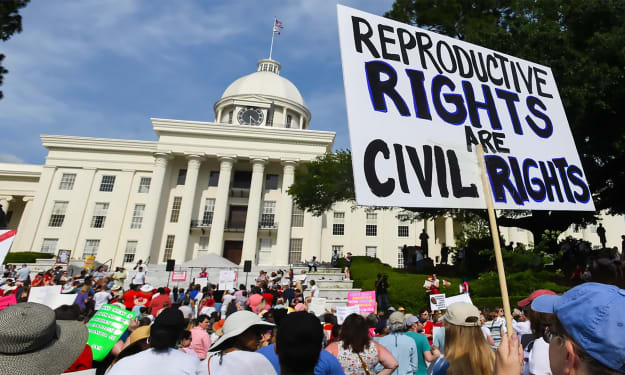Content warning
This story may contain sensitive material or discuss topics that some readers may find distressing. Reader discretion is advised. The views and opinions expressed in this story are those of the author and do not necessarily reflect the official policy or position of Vocal.
US Steel investors vote on dubious Nippon bargain
Business

Title: Investor Standoff: The Disputable Nippon Arrangement Partitions US Steel Financial backers
In the high-stakes universe of steel fabricating, each choice conveys massive weight, from key organizations to significant acquisitions. Thus it was with US Steel, one of America's most established and biggest steel makers, as investors assembled for a crucial decision on a disputable arrangement with Japanese combination Nippon Steel.
The proposed bargain, which had been a long time really taking shape, tried to lay out a joint endeavor between US Steel and Nippon Steel, determined to improve seriousness and opening new learning experiences in the worldwide steel market. Under the conditions of the arrangement, Nippon Steel would put billions of dollars in US Steel in return for a critical stake in the organization, giving it a traction in the worthwhile North American market.
For US Steel, the arrangement addressed a likely life saver in an undeniably difficult industry scene, set apart by furious contest, unstable item costs, and moving exchange elements. With Nippon Steel's monetary support and mechanical mastery, US Steel wanted to modernize its activities, advance productivity, and position itself for long haul progress in an always developing business sector.
In any case, for some investors, the proposed bargain raised serious worries and started warmed banter inside the organization and on Money Road. Pundits highlighted Nippon Steel's checkered past, including claims of hostile to serious way of behaving and ecological infringement, as motivations to be careful about the organization. They expected that lining up with Nippon Steel could discolor US Steel's standing and undermine its obligation to moral strategic approaches.
In addition, a few investors scrutinized the provisions of the actual arrangement, communicating doubt about the valuation of US Steel and the expected weakening of their proprietorship stakes. They stressed that the flood of capital from Nippon Steel could come to the detriment of existing investors, prompting a deficiency of control and decreased returns over the long haul.
As the date of the investor vote moved close, pressures ran intense inside US Steel's meeting room, with chiefs separated over the benefits of the proposed bargain. On one side were defenders of the organization, who contended that uniting with Nippon Steel was important to get the organization's future in the midst of mounting difficulties. They referred to Nippon Steel's history of advancement and its abundant resources as convincing motivations to help the arrangement.
On the opposite side were cynics and dissidents, who raised legitimate worries about the dangers and ramifications of the association. They called for more noteworthy straightforwardness and an expected level of effort prior to continuing with the arrangement, encouraging individual investors to gauge the likely advantages against the potential disadvantages cautiously.
As the moment of retribution showed up, investors from the nation over united on US Steel's central command in Pittsburgh for the profoundly expected vote. The climate was electric, with expectation and vulnerability lingering palpably as financial backers arranged to project their polling forms on the fate of the organization.
Inside the conference center, pressures stewed as investors listened eagerly to introductions from the two sides of the discussion. Leaders from US Steel and Nippon Steel made energetic supplications for help, promoting the expected collaborations and competitive edges of the proposed association.
In any case, as the conversation unfurled, obviously the result of the vote was not even close to certain. Investors brought up examining issues and voiced their interests, testing the arrangement's better subtleties and squeezing for affirmations on major questions like administration, straightforwardness, and administrative consistence.
Outside the conference center, nonconformists accumulated to voice their resistance to the arrangement, displaying signs and reciting trademarks impugning the association with Nippon Steel. They approached investors to dismiss the arrangement and maintain US Steel's inheritance as an American symbol, untainted by unfamiliar impact or corporate impropriety.
As the hours ticked by, pressures arrived at an edge of boiling over, with feelings running high on the two sides of the discussion. Eventually, it boiled down to a nail-gnawing vote, as investors cast their voting forms in an essential second that would shape the fate of US Steel for quite a long time into the future.
At the point when the last count was reported, the room emitted into cheers and commendation, as investors conveyed a conclusive decision on the disputable Nippon bargain. In a staggering censure to the executives' proposals, the arrangement was predominantly dismissed, sending shockwaves through the business and flagging another part in US Steel's celebrated history.
As the residue settled and financial backers wrestled with the ramifications of the vote, one thing turned out to be unmistakably clear: in the merciless universe of steel fabricating, the voice of the investor is an awe-inspiring phenomenon, fit for molding the predetermination of even the mightiest of enterprises. Furthermore, as US Steel diagrammed another course forward, it did as such with a newly discovered feeling of direction and assurance, directed by the upsides of straightforwardness, trustworthiness, and investor responsibility.
The resonations of the investor vote reverberated a long ways past the walls of US Steel's central command, sending shockwaves through the steel business and resounding across monetary business sectors. As insight about the arrangement's dismissal spread, investigators and financial backers mixed to evaluate the aftermath and recalibrate their assumptions for the fate of US Steel and its rivals.
For US Steel, the vote addressed a critical difficulty and a sobering indication of the difficulties ahead. The organization had wholeheartedly put its faith in the proposed association with Nippon Steel as a way to rejuvenation and development in an undeniably serious market. With the arrangement currently off the table, US Steel confronted recharged strain to follow through on its commitments of functional improvement and monetary execution.
In the fallout of the vote, questions waited about the organization's essential course and authority. Investors clamored for replies, requesting straightforwardness and responsibility from the board directly following the bombed bargain. In the midst of mounting examination, US Steel's chiefs regarded themselves as on edge, confronting extreme inquiries concerning their stewardship of the organization and their arrangements for what's in store.
Outside the meeting room, industry experts discussed the ramifications of the decision in favor of the more extensive steel area. Some saw the dismissal of the Nippon bargain as an indication of developing investor activism and a recharged center around corporate administration and responsibility. They hailed the vote as a triumph for investor privileges and a demonstration of the force of financial backer activism in molding corporate navigation.
Others, be that as it may, communicated worry about the effect of the arrangement's disappointment on US Steel's cutthroat position and long haul suitability. They cautioned that without the monetary support and aptitude of Nippon Steel, US Steel could battle to stay up with its adversaries in an undeniably globalized and mechanically progressed industry. The organization's stock cost tumbled directly following the vote, reflecting financial backer vulnerability about its possibilities in a post-Nippon world.
In the midst of the vulnerability and unpredictability, US Steel's authority confronted an overwhelming test: to diagram another course forward following the arrangement's breakdown. The organization left on a far reaching key survey, investigating elective ways to development and worth creation in a quickly changing business sector scene.
One likely road for US Steel's future development lay in mechanical advancement and functional greatness. The organization put vigorously in innovative work, trying to use state of the art advancements and cycles to upgrade efficiency, diminish costs, and further develop item quality. By embracing computerization, man-made consciousness, and progressed examination, US Steel expected to situate itself as a forerunner in the computerized change of the steel business.
One more key center region for US Steel was maintainability and natural stewardship. Perceiving the developing significance of ESG (ecological, social, and administration) variables to financial backers and clients the same, the organization put forth purposeful attempts to diminish its carbon impression, limit squander, and advance capable obtaining rehearses. By adjusting its strategic policies to supportable improvement objectives, US Steel tried to upgrade its image notoriety and draw in socially cognizant financial backers.
Notwithstanding these essential drives, US Steel investigated open doors for key associations and partnerships with other industry players. By producing cooperative associations with providers, clients, and contenders, the organization planned to open new learning experiences and make an incentive for investors. From joint endeavors and key partnerships to consolidations and acquisitions, US Steel stayed open to investigating all choices for driving long haul esteem creation.
As US Steel explored the fierce waters of the post-Nippon time, one thing stayed clear: the organization's strength and assurance would be scrutinized as it tried to conquer difficulty and arise more grounded than at any other time. With a recharged center around development, maintainability, and vital organizations, US Steel stayed focused on conveying an incentive for its investors and partners the same, guaranteeing a more promising time to come for the notorious American steelmaker in the years to come.
About the Creator
Ananta Kumar Dhar
Welcome to my corner of Vocal Media! I'm Ananta Kumar Dhar. Drawing from my background as a Contain Writer & Graphic Designer a dedicated wordsmith fueled by curiosity and creativity.
Enjoyed the story? Support the Creator.
Subscribe for free to receive all their stories in your feed. You could also pledge your support or give them a one-off tip, letting them know you appreciate their work.






Comments
There are no comments for this story
Be the first to respond and start the conversation.